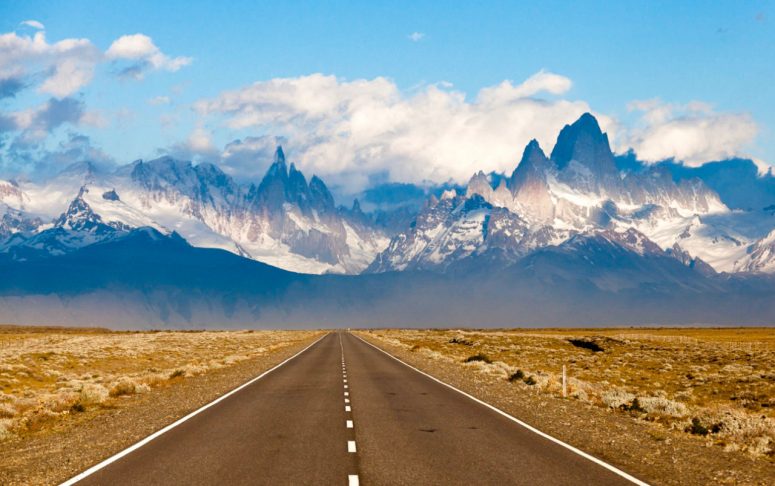The time I hiked Patagonia with National Geographic

It took the world a long time to discover Patagonia, the trendy adventure area shared by both southern Chile and Argentina. While other mountaineers had been hiking and climbing the Alps and Rockies for over a century, Patagonia wasn’t explored much until the 1980s. In fact, the recreational area didn’t become mainstream until the 21st century, when more accessible transportation, lodging and tourist amenities were finally added.
What’s all the fuss about? In between knife-like mountains, this is arguably the best place in the world to see moving glaciers. It is also a great place to meet gentle but playful people.
Last month I had the chance to examine this hauntingly majestic land up close on a guided tour with National Geographic Expeditions, the society’s official tour operator. Spoiler alert: it was a once-in-a-lifetime experience. Here’s what I witnessed hiking to what some call South America’s greatest “national park.”
Surreal Summits
When people say they’re “going to Patagonia,” they usually mean the massifs of either Torres Del Paine (pronounced “Piney”) in Chile or Fitz Roy in Argentina. After all, greater Patagonia is nearly twice the size of Texas and mostly barren.
What makes these mountains so special, then? 1) Both have vertical drops of around 10,000 feet from the viewing floor, which appears more impressive than mountains of equal height but with lesser prominence. 2) These peaks are more like steeples than the traditional triangles you’re used to seeing. Like mountain-sized shanks dusted with powdered sugar. This effect makes them appear more sinister than other ranges. Indeed, one indigenousness interpretation of Paine reputedly means “don’t go there.”
But like an insect attracted to electric blue light, you’ll be drawn to the famous “W” hike around Paine’s greatest features: Gray Glacier, French Valley, Los Cuernos, and the namesake three-pronged towers (or torres), one of the most magnificent viewpoints on the planet.
Until you get to nearby Fitz Roy. Although I adore the Grand Tetons, the combination of Cerro Torre and Fitz Roy peaks (pictured) are 2-3 times as grand as the former. I can see why an entire outdoor company was named for this place.
Forces of Nature
Before you enter either Torres Del Paine or Glaciares National Parks, you’ll be properly introduced to wind like you’ve never heard, felt or seen before. You can hear it as it howls up to 60-100 miles per hour. You can feel it as it almost (and sometimes) knocks you down. And you’ll see it in sideways growing trees, oddly shaped stratocumlus clouds racing across the sky, and water spouts or sheets of mist that cross emerald lakes in airborne waves.
The prevailing wind is so forceful here, even the stalactites of Milodon Cave are bent. In short, my respect for and awareness of wind grew considerably on this trip. So did my appreciation for rainbows. While driving to the interior from Punta Arenas, I counted eight rainbows in a two-hour period. Two doubles even. So intense.
Then I saw this:

It’s called Perito Moreno Glacier, and it’s probably the most impressive and powerful sight I’ve seen (and heard) in my life. Massive doesn’t begin to describe it. While hiking it, I heard the glacier creak and explode. I swear I felt it move. Then I alertly watched as deathly chunks (and once an entire 240-foot column) exploded into the turquoise water of Lake Argentino. After spending a day with it, I completely understand why it’s the top-rated destination in all of Argentina.
In Patagonia, you don’t just observe your surroundings. You are overcome by them.
Paramount Guidance
There are cheaper ways of hiking Patagonia than with National Geographic. But after following their encyclopedic, passionate and considerate guides for two weeks, I believe I gained exponentially more from the experience than I would have otherwise.
For instance, our beret-wearing, mountain-climbing leader from Chile (named Tomas) seemingly knew all the tricks. We always beat the crowds. Always made the best stops. Always kept the right pace. And always found the most secluded viewpoints. His guidance was so good, even onlookers asked (on more than one occasion) who I was touring with.
But more than just getting us from point A to point B in the best and safest way possible, Tomas and his cadre of local experts enlightened and united us. They enriched us with local gaucho jokes and culture. Taught us how to pick delicious berries from El Calafate, which taste of blueberry and raspberry.
They explained all manner of flora, fauna and wildlife. Steered us towards the best lodges, restaurants, and local foods—save a mate, lamb steak, merken chili pepper, and dulce de leche for me! When a hiker in our group suffered dehydration, the tag-team guides quickly revived and made it possible for him to rest and catch up with us the following day.
In short, we had the most accomplished guides on the trail, the finest service, the most well-designed itinerary, and probably learned more about this remarkable region than anyone else. It’s no wonder I encountered so many NatGeo repeat customers.
The Final Word
In Patagonia, there is an old gaucho saying: “This is life; the rest are lies.” You can convincingly say things like that when you wander such a marvelous place. Not just for the aforementioned mountains, valleys and glaciers, but also for the greens, blues, yellows, oranges, whites and grays you’ll behold along the way.
Although my travels are in no way exhaustive, I’ve had the privilege of seeing some of the world’s most renowned landscapes. And I’d be lying if I didn’t declare Patagonia one of the most imposing I’ve ever visited. ●
This story first appeared in Paste Magazine on February 9, 2017

For a long time, I’ve said that if I ever win the lottery, I’ll just disappear and take a monthlong Nat Geo Expedition to Antarctica (via the Galapagos). So, uh, congrats on winning the lottery of life! 🙂